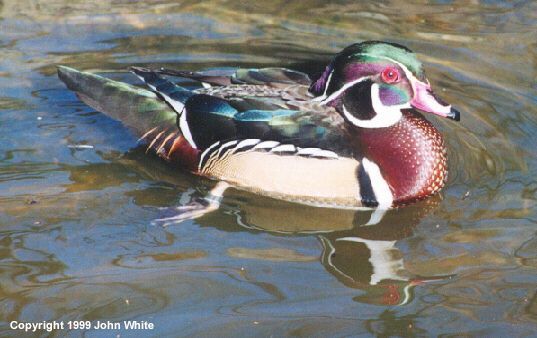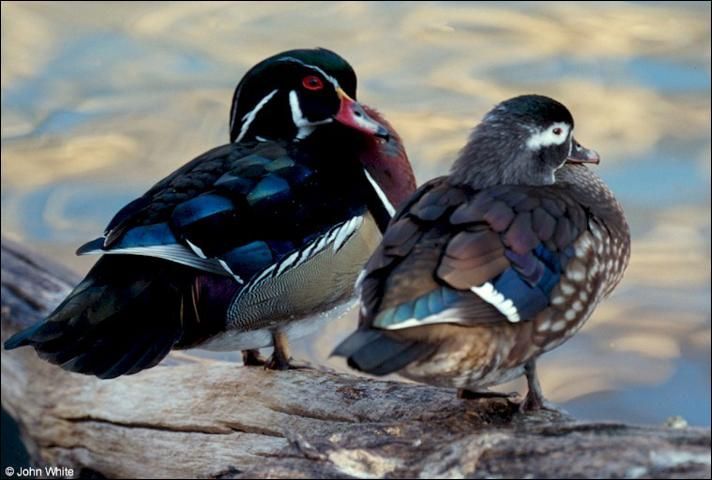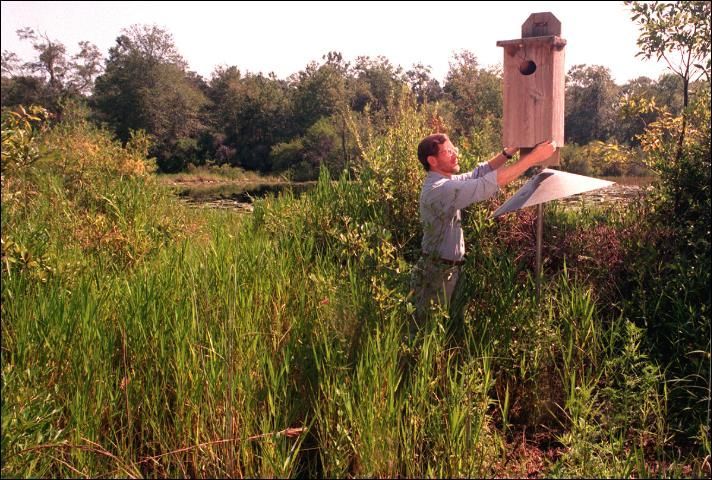Without question, the wood duck (Aix sponsa) is one of the most colorful of all North American waterfowl. It has a striking mixture of iridescent blues, greens, and purples contrasted by white stripes and patches (Figure 1). Its coloration has made it the most sought-after duck by hunters and birdwatchers.

Credit: John White
It is known in Florida as the "summer duck" and the "acorn duck." By the early 1900s, this highly desirable species was near extinction because of improper hunting regulations and habitat loss. With the Federal Migratory Bird Treaty Act in 1918, hunting of these birds was restricted. Also, wildlife officials developed a management program to increase wood duck numbers. This program consists of yearly monitoring of the population, appropriate hunting regulations based on monitoring data, captive breeding, and the use of nest boxes. Due to the success of this program, the wood duck is now one of the most abundant waterfowl species in North America.
Description
Both drake (male) and hen (female) wood ducks (Figure 2) can be distinguished from other flying ducks by their relatively large head, short neck, and long square tail. These ducks also have a long, slicked-back head crest. Male wood ducks have larger chins than female wood ducks, and they have finger-like extensions on the chin and neck. Like most duck species, the male is more colorful, with a red bill and eyes. Females are mostly gray and brown with a white ring around their eyes. The drake's high-pitched whistle, "jeeeee," and the hen's low, owl-like "whoo-w-eet" call can be heard as they fly.

Credit: John White
Range
Wood ducks are commonly found throughout North America from British Columbia and Quebec, Canada, as far south as Mexico and Florida. The wood duck is one of the few duck species that breed and nest in Florida. In addition, wood ducks that nest in higher latitudes migrate south and overwinter in Florida and other states bordering the Gulf of Mexico. Some individuals migrate to Mexico and Cuba. Migration back north occurs in mid-March.
Habitat
All ducks live near water. The wood duck, as its name implies, also requires wooded cover. They prefer swamps and even upland forests within one-half mile from permanent freshwater wetlands, ponds, creeks, and rivers. The ideal water habitat is one with an interspersion of diverse shrubs (30%), emergent herbaceous plants (40%), trees (5%), and open water (25%). The shrubs and emergent plants provide cover and also places where the young can find plenty of insects and the adults can feed on seeds and fruits. Adults perch on tree branches over water to preen (clean and oil their feathers) and rest.
Wood ducks nest in tree cavities. Their use of trees keeps them out of reach from skunks and foxes (major nest predators for ground-nesting ducks) and also makes them less available to other predators such as opossums (Didelphis virginiana), raccoons (Procyon lotor), and snakes. After the nesting season, adults molt all of their feathers at once. The ducks are consequently unable to fly until their new flight feathers emerge, about 21 to 28 days. They avoid predation by staying in thick wooded areas and on water. They prefer large deciduous hardwood trees: tupelos, oaks, and cypress swamps. This type of cover also helps to protect from predators such as snakes, opossums, and raccoons.
Feeding
The wood duck is one of the "dabbling" ducks that obtain most of their food by bending forward until their tail sticks straight upward while they feed in shallow water. Unlike most other ducks, wood ducks also obtain much of their food by foraging on the ground in woody swamps and bottomland hardwood forests. Most of the adults' diet consists of seeds, fruits, and other plant parts. Only about 10% is animal matter (spiders, insects, snails, and crawfish). Laying hens and ducklings satisfy their high protein demand by eating a greater percentage of animal foods. Preferred plant foods include duck weeds; cypress cone scales and galls; tubers; seeds of sedges, rushes, and grasses; and fruits and seeds of water elm, ash, wild grape, swamp privet, buttonbush, beech, tupelo, blackgum, and hickories.
They are especially fond of small acorns from water oak, laurel oak, and Shumard oak. Although wood ducks forage on the forest floor and even in trees, they prefer acorns that fall into shallow water.
Preferred agricultural crops are browntop millet, buckwheat, corn, dove proso, foxtail millet, grain sorghum, Japanese millet, pearl millet, and soybeans.
Reproduction and Nesting
The wood duck is one of only a few duck species that nest in Florida. Courtship and pairing take place during winter. In early spring, the drake follows the hen to a nest tree she used the previous year or to the general area where she was hatched. For instance, a drake hatched in Florida may pair up with an overwintering hen from another state and follow her to her northern natal area for the nesting season.
Suitable nest trees have cavities, are within one-half mile of permanent water, have clear and easy access, and have shrubs close by to conceal the ducklings as they walk from the nest tree to the water. For nesting, they favor willow, maple, ash, and sycamore trees with a trunk that measures at least 24 inches in diameter at about 4 feet above the ground. The height of the nest above the ground or water ranges from 3 to 60 feet. They will nest in old pileated woodpecker (Dryocopus pileatus) holes. Wood ducks also readily nest in artificial cavities and boxes (see Habitat Management section).
Because wood ducks do not bring in nest material, the cavity should contain some litter (rotten wood) to form a base. The hen covers the eggs with her down feathers. Egg-laying starts in late January (the peak is February and March), with one ivory-colored egg laid every day until the clutch is finished (typically 10 to 15 eggs). Occasionally, more than one hen will lay in the same nest. However, the hens usually desert these "dump nests." Two females occasionally use the same cavity, incubating in turn or simultaneously. Incubation begins the day after the last egg is laid and lasts about 30 days. During incubation, the hen usually leaves the nest twice a day, early in the morning and late in the afternoon, to feed and rest with her mate. Toward the end of incubation, the drake leaves the family to molt with other males and never returns.
Ducklings usually leave the nest the day after they are hatched. At the hen's call, they use their sharp claws to climb to the entrance of the tree cavity or nest box. They pause momentarily at the entrance before jumping, sometimes from as high as 70 feet. They hit the ground or water uninjured. After the entire brood is out, the hen leads them to water.
The hen usually remains with her brood until the young are able to fly (about 9 weeks). The mortality rate (due primarily to predation from turtles, alligators, snakes, bass, etc.) of ducklings is quite high. Normally, only 3 to 4 from a brood survive to the flying stage. The hen, after leaving her brood, also molts during late summer. One brood per year is normal, but two broods can occur.
Health Issues
Ducks are susceptible to a variety of diseases including Avian Influenza, Duck Plague (Duck Virus Enteritis), Avian Cholera, Botulism, Aspergillosis, Sarcosporidiosis (Rice Breast), and lead poisoning. Some of these, such as Botulism, are deadly and can be transmitted to humans. Where ducks and humans occur together, proper hygiene precautions should be followed. For more information on these diseases, see "Common Poultry Diseases" (PS-47), at https://edis.ifas.ufl.edu/ps044. Other useful publications on the topic, "Avian Diseases Transmissible to Humans," are available here: https://edis.ifas.ufl.edu/topics/avian_influenza. If you do not have access to the internet, you can get these publications from your local UF/IFAS Extension office.
Whenever diseased animals are encountered, contact your local office of the Florida Fish and Wildlife Conservation Commission (FFWCC).
Maximum life span of the wood duck is about 15 years, but few live to be more than 3 or 4 years old. In the fall, the young that hatched in the spring of that year make up about 70% of the population.
Hunting
Because ducks migrate through many states, a federal agency, the United States Fish and Wildlife Service, establishes duck-hunting seasons and bag limits for each state. The aim is to maintain a healthy national population of ducks while providing fair and equal opportunities for hunters in all states. To hunt any duck species in Florida, one must have a Florida hunting license and a free Florida Waterfowl permit. These can be obtained from county tax collectors and their subagents, such as hunting supply stores, or by calling 1-888-486-8356.
Regulations on duck hunting include season length and number of killed birds allowed per person per day during the season. These laws may change from year to year as biologists try to provide duck hunting opportunities while also protecting the populations. Current regulations should be checked before hunting (see website at http://myfwc.com/hunting/regulations/birds/).
Habitat Management
Food
Planting or maintaining some of the plants mentioned above in the section "Feeding" will assure good food sources. Occasional flooding of bottomland hardwoods and agricultural crops also may enhance the availability of some preferred foods. In some situations, selective thinning of bottomland hardwoods is recommended. Thinning helps boost the mast production from large trees ("mast" refers to acorns and seeds). Check current regulations before hunting to see if you are allowed to hunt over the planted crops.
Nesting Cover
Shrub and emergent plant growth in some shallow ponds or lakes may be too thick. In these situations, wood duck use will be more likely if the plants are thinned out to create about 25% open water. Providing water in previously drained forested wetlands or agricultural areas will also provide habitat.
One of the best things you can do is to provide a wood duck nest box (Figure 3). Due to the shortage of suitable tree cavities, wood ducks will also live in artificial cavities or nest boxes. Females tend to return to their former nest site or to the general area where they were hatched. Knowing about this behavior has helped wildlife biologists increase the breeding population in different areas by adding and maintaining nest boxes where they know wood ducks have nested or hatched in the past. Instructions for constructing a nest box for wood ducks can be found in this article: https://www.audubon.org/news/how-build-wood-duck-nest-box.

Credit: UF/IFAS
Nest boxes can be erected on an isolated tree or on a 16-foot long, 4 x 4-inch metal or wooden post made of cypress, cedar or pressure-treated pine. Make sure that the nest box is in the shade and is not more than one-half mile away from a permanent water body. For nest boxes mounted over land, wood ducks seem to prefer nest boxes mounted at least 20 feet above the ground. Shubbery or grassy vegetation should also be beneath the box. Because the hen must lead her ducklings to water after they hatch, the habitat between the box and the water's edge should be free from major obstacles such as highways, fences with small mesh, and street curbs. Also, the area should be free of domestic pets that might prey on ducklings. Nest box entrances near water should face the water. Boxes over water should be placed from 5 to 10 feet above the water surface. If the water level fluctuates, start your measurement at the high-water elevation, or high-water mark if visible on an existing post.
It is important that boxes be placed so they are quite visible to ducks; for this reason, they should not be placed in thick growth or painted to blend into the surroundings. Boxes with black circles painted on the sides might attract passing hens that only see the box from the side and think the circle is a cavity hole.
Remember, females return to the area where they were hatched and will nest close to their relatives. However, it is important to prevent nest dumping. Place nest boxes at least 600 feet apart and make sure they are not visible to one another.
For placing nest boxes on trees, they should be located from 30 to 150 feet away from the shoreline. Boxes placed directly on the shoreline may be more prone to be raided by nest predators. Try to avoid places on the tree where raccoons and squirrels (Sciurus spp.) will be able to jump easily onto the nest box from nearby trees. For nest boxes over the water, a cone-shaped predator guard should be installed on the pole beneath the nest box (Figure 3). For more information about constructing a nest box and predator guard, follow this link to website: https://www.nrcs.usda.gov/Internet/FSE_DOCUMENTS/stelprdb1045457.pdf.
Clean the nest boxes yearly between August 1 and April 1. Put new wood chips or shavings inside. Repair the box as needed. Cut off branches that obstruct the entryway or are too close to the roof.
Additional Resource
Website for additional information:
Fish and Wildlife Habitat Management publication on Wood Duck (Aix sponsa). 12 pages. USDA Natural Resources Conservation Service, Wildlife Habitat Management Institute, and the Wildlife Habitat Council. https://www.nrcs.usda.gov/Internet/FSE_DOCUMENTS/stelprdb1045457.pdf [26 June 2012].